|
Television Experimenters.com
Charles Francis Jenkins

Charles Francis Jenkins
Charles Francis Jenkins, (1867-1934) was born "in the country" just north of Dayton, Ohio. He spent his boyhood on a farm near Richmond, Indiana He attended a country school, a nearby high school and Earlham Collage. In 1890 he settled in Washington D.C. to serve as Secretary to Sumner Kimble of the U.S. Life Saving Service. (This later became the U.S. Coast Guard). Five years later he resigned, so he could spend his full time inventing. One of his first
projects was a motion picture projector, using a strip of sprocketed film. He built an patented an operating prototype, the "Phantoscope" similar to those now found in ever movie theater in the world. (Note: It was commonly thought that Thomas Edison invented the movie projector. This is not true.) His interest in motion pictures was so great in 1916, Mr. Jenkins went to form the Society of Motion Picture Engineers and was its first president. The Society
is now a high respected worldwide organization. Mr. Jenkins also invented the spiral-wound waxed all paper container, still in regular use as a food container. (EX: Pillsbury biscuits), mailing tubes and a manufacturing process for large shell casings for field artillery.
|
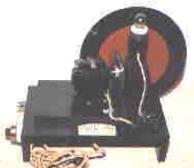
Radiovision Receiver |

Jenkins Radio Movies |
Even as a small boy, Mr. Jenkins was an avid reader of technical books and magazines. Undoubtedly he read of some of the early principals of television and kept these thoughts in mind, because in 1894, he wrote an article for the July 25 issue of "Electrical Engineer" on the subject of transmitting pictures by wire. It was a natural progression for him to go into few well-chosen friends, he set up a research laboratory in
Washington D.C. to investigate the development and construction of practical television transmitting and receiving apparatus. At first he needed to learn of the techniques of
scanning and his first venture would be the transmission of still pictures by wireless. He successfully demonstrated this capability to the Navy on December 12, 1922. This was called photo radio or facsimile radio. By 1924 he improved the apparatus by incorporating his prismatic rings scanner. This provided received pictures without lines that looked much like a photograph. The Jenkins prismatic rings, which provided a
unique means of scanning, were originally developed for a high-speed movie pplication. However they proved to be too costly for use in Radiomovies.
By 1925, Mr, Jenkins had progressed to Radiovision, Radiomovies and Television. He was sending movies by radio from a standard moving picture machine to a small screen on a radio receiver in another room in the Jenkins laboratory. On June 13, 1925, he gave a successful Radiovision demonstration to the Navy with the transmitter in Anatosia, at the Naval Laboratory station NOF and the receiver in the Jenkins Laboratory. The receiver used a Nipkow disk equipped with lenses. |
Up to this time, Mr. Jenkins had not made an effort to interest the general public or at least the radio amateurs. He did not recognize the possibility of a monetary benefit there. Potential sales to the Navy were a more immediate enticement for him. At some point, he decided to install and operate a transmitter for Radiomovie picture stories, with announcements describing the pictures. He applied to the FRC (later became the FCC) and on July 2, 1928 with a format of 48 lines and 15 pictures per second. The picture stories were silhouetted adults and children doing common things. In announcements between stories, amateurs were asked to write in and give their opinions of the show and tell how well the pictures were received. Those that only heard the announcements because they had no picture attachments, were urged add them to their receivers. Jenkins offered the picture attachments such as disks, lamps, motors etc., at very low prices. Many did buy what they needed and for those that wanted to layout their own scanning disk, Mr. Jenkins was giving complete instructions via the broadcasts or by mail when requested to do so. After a time, Jenkins began manufacturing a complete low cost picture attachment and sold it below cost for $7.50 complete. Following the first broadcast, the picture stories were broadcast every evening at 8:00 PM EST., except Sundays and holidays. Mr. Jenkins estimated his audience to be between 18,000 and 20,000 "lookers-in".
To produce the silhouette films, Mr. Jenkins set up a special studio that allowed him to make the silhouette films at very low cost. The adult actors were actually laboratory staff, except for the children who were local kids from the neighborhood. The silhouettes were very popular with the "lookers-in". One was "The Old Dutch Girl" of a cleanser advertisement. Transmitting only a large picture of the Dutch cleanser can, clearly showed the possibility of television commercials. At one point, he considered doing a commercial for Campbell's Soup in this way. Other silhouettes included "The Little Girl Bouncing a Ball", "The Washwoman", "Two Girls on a Seesaw" and another girl jumping rope, then putting it away and turning somersaults.
Silhouettes only were sent because due to some bad information given to Mr. Jenkins by his chief engineer, he was led to believe that producing various image shades would require more bandwidth than the legal 5Khz available. Later, the FRC did authorize him to use a 100 kHz band from 4.9 to 5.0Mhz. To take advantage of the added bandwidth, Mr. Jenkins developed and produced a new 60-line lens disk model with a companion receiver. A pair of these is on display at the Wayne County Museum in Richmond, Indiana. |
In 1929, the Jenkins Television Corporation (of New Jersey) became a subsidiary of the Deforest Company, who took control of all devices developed by the Jenkins Laboratories as well as its merchandising. Mr. Jenkins was named a Vice-President and retained control of the Jenkins Laboratories in Washington D.C. until 1930, when he resigned. He resigned partly because of ill health at the time and mostly because he was no longer in control and those that were would not cooperate with him. They felt that they had a "white elephant" on their hands. |
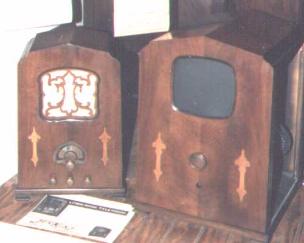 |
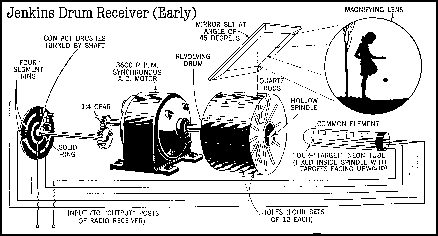
Jenkins Drum Receiver
A few important elements of Mr. Jenkins early apparatus deserve a fuller description so one may better appreciate his work as an inventor. Two of these relate to mechanical scanners for television receivers. The problem to be solved was that the image size obtainable with the Nipkow disk was very small for a given size disk. For example, 2 foot diameter disk for a 48 line picture would provide an image about 1.5" square. |
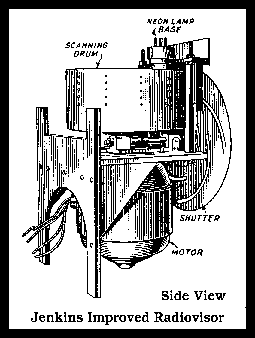
Side View Jenkins Scanner
|
The cabinet necessary to house this 25" disk would be quite large, so a more compact scanning system would be desirable. Mr. Jenkins developed two mechanisms to accomplish this. The first one used a drum about 8" in diameter with four spirals of holes. In the center of this tube was a metal tube, also containing four spirals of holes, rotating with the drum and around a fixed special four element neon lamp. Between each hole in the cabinet necessary to house this 24" disk would be quite large, so a more compact scanning system would be center tube, there was a quartz or glass rod to pass light from that hole to an appropriate hole in the outer drum. A motor drove the drum at 3600 RPM and through a gear reduction, a commutator that selected one of the four lamp elements in a repeating sequence at 900 RPM. The picture appearing on the drum was over 2" square. It would have required a 36" scanning disk to equal this. This model was built and demonstrated successfully, but the lamp life was very short and a less expensive overall design was desired. A six-spiral model with a similar drum had also been considered. It would have provided an even larger picture. It to was abandoned for the same reason as the first. The second model used a similar four spiral drum but with no center tube, commutator or quartz/glass rods. It also used a low cost standard large plate neon lamp. |
The next model used a similar four spiral drum but with no center tube, commentator or quartz or glass rods. It also used a standard low cost large plate neon lamp. In addition, there was a selector shutter that as it rotated, allowed only one spiral on the drum to be active at a time and to pass picture information to the viewer. The motor drove the drum at 3600 RPM and through a reduction gear, the selector shutter
at 300 RPM. Both of these mechanisms required a much smaller motor than might have been necessary with a 36" disk. This second model was placed on the market and sold to the public. Mr. Jenkins was also manufacturing professional scanning disk television cameras and accessories. Many were sold to technical schools for training purposes
and broadcast stations throughout the United States. In 1931, it was reported that Mr. Jenkins was very seriously ill. His illness lingered and some three years later he passed away. He had led a very productive life. All together, he held over 400 patents, some 72 of which related directly to Radiovision, Radiomovies and television.Mr. Jenkins had a sign in his office that he lived by. It said this: "If a thing is difficult; it is as good as accomplished. If it is impossible, it will take a little bit of time". |
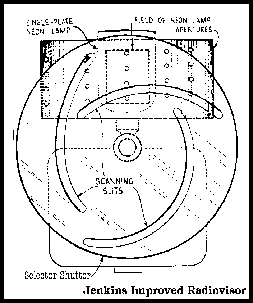
|

All rights reserved.
|